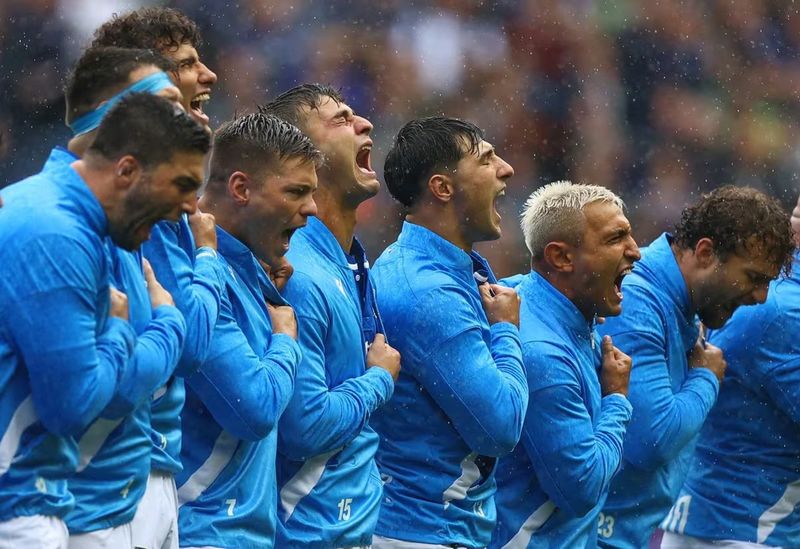Introduction:
In the grand tapestry of global rugby, Italy's presence might be considered a recent addition, but it's a story of resilience, evolution, and a passionate pursuit of sporting excellence. While the echoes of football dominate Italy's sporting landscape, rugby has carved its niche, growing from humble origins to become a force to be reckoned with. This article embarks on a captivating journey into the heart of Italian rugby, exploring its historical foundations, the evolution of playing styles, the emergence of iconic players, the guiding hands of notable coaches, and the impact of the sport on the nation's cultural identity. From the early struggles to establish rugby in a football-centric nation to the triumphs and challenges faced on the international stage, we unravel the unique narrative that defines Italian rugby. Join us as we delve into the rich history, celebrate the indomitable spirit of the Azzurri, and witness the ongoing renaissance that promises a vibrant future for rugby in the heart of Italy.
Historical Foundations: Pioneering the Oval Journey
The roots of Italian rugby stretch back to the late 19th century, a period marked by the sport's global proliferation. As Italy embraced rugby, it embarked on a journey filled with challenges, triumphs, and the forging of an enduring legacy.
Rugby's initial introduction to Italy can be traced to British expatriates and students, who, amidst the scenic backdrop of the Italian countryside, introduced the oval ball game. The seeds planted in these early encounters soon sprouted into the formation of the nation's first rugby clubs, a testament to the sport's universal appeal.
Despite the enthusiasm, rugby faced an uphill battle in Italy, a country enamored with football. The sport grappled with limited resources, minimal infrastructure, and the formidable shadow cast by the nation's favorite pastime. Yet, a passionate community of players and enthusiasts, fueled by the allure of a different kind of sporting spectacle, persevered.
The emergence of the Italian national rugby team marked a significant milestone in the late 1920s. Their early years were marked by sporadic fixtures against neighboring nations, laying the groundwork for a more structured and competitive future. However, the onset of World War II temporarily interrupted this progress, and it wasn't until the post-war period that Italian rugby began to gather momentum.
In the late 1950s and early 1960s, the formation of the Federazione Italiana Rugby (FIR) provided a pivotal organizational framework. This signaled a commitment to the sport's development and set the stage for Italy's entry into the European rugby arena.
The inaugural edition of the Five Nations Championship in 2000 marked a watershed moment for Italian rugby. This invitation to the prestigious tournament, alongside England, France, Ireland, Scotland, and Wales, represented a recognition of Italy's growing prowess and a nod to its place among rugby's elite.
The historical foundations of Italian rugby are, however, not solely defined by victories and accolades. The sport's growth in Italy has been a story of resilience, with every setback met by a spirited comeback. The struggles of the early years, coupled with the formidable competition in international rugby, became stepping stones for the Azzurri.
Sergio Parisse, a colossus in Italian rugby, exemplifies the enduring spirit of the Azzurri. His leadership, commitment, and sheer skill have not only left an indelible mark on Italian rugby but have also inspired a new generation of players. Parisse's journey, from a rugby aspirant in Argentina to becoming the most-capped Italian player, symbolizes the tenacity required to lay down historical foundations.
As we navigate through the historical foundations of Italian rugby, we encounter tales of passion, determination, and the unyielding pursuit of excellence. From the modest fields where rugby first took root to the grand arenas of international competition, Italy's rugby journey is a testament to the sport's power to transcend cultural boundaries and become a cherished part of the nation's sporting identity.
Evolution of Italian Rugby: A Renaissance on the Field
The evolution of Italian rugby is a captivating narrative, a journey that mirrors the nation's ascent from rugby novices to formidable contenders on the global stage. From the rudimentary playing styles of the early years to the strategic sophistication of the modern era, Italy's rugby story reflects resilience, adaptation, and an unrelenting commitment to improvement.
In the early stages of Italy's rugby evolution, the team faced the formidable challenge of navigating through established rugby powerhouses. The physicality and intensity of the Six Nations, in particular, posed a steep learning curve. However, these challenges were embraced as opportunities for growth rather than insurmountable obstacles.
The late 1990s marked a significant turning point for Italian rugby with the appointment of coach Brad Johnstone. His tenure brought a new level of professionalism and structure to the team, setting the stage for Italy's participation in the inaugural Six Nations Championship in 2000. This entry into the premier European competition was a watershed moment, signaling Italy's formal arrival on the international rugby scene.
The evolution of playing styles has been a dynamic aspect of Italy's rugby renaissance. Early on, the team relied on a robust forward-oriented approach, drawing inspiration from the nation's rugby foundation. The pack's physicality and set-piece proficiency became trademarks, but as the sport evolved globally, so did Italy's strategy.
In the modern era, Italian rugby has embraced a more expansive style of play. The evolution of backline creativity and the incorporation of skillful playmakers have added flair to the Azzurri's game. Players like Andrea Masi and Mirco Bergamasco brought an attacking edge, showcasing Italy's adaptability and willingness to embrace the evolving dynamics of international rugby.
The strategic nuances of Italian rugby have been further shaped by the influence of notable coaches. The appointment of Nick Mallett in the mid-2000s brought a renewed focus on developing the team's tactical acumen. Mallett's tenure, marked by a pragmatic approach and a commitment to defensive solidity, laid the groundwork for Italy's competitive performances.
Subsequent coaches, including Jacques Brunel and Conor O'Shea, continued to refine Italy's playing style. The emphasis on skill development, fitness, and a more expansive brand of rugby became key focal points. O'Shea, in particular, sought to cultivate a sense of adventure in the team's approach, encouraging players to express themselves on the field.
The emergence of influential players has been a crucial aspect of Italy's rugby evolution. Sergio Parisse, a stalwart of Italian rugby, stands as a symbol of consistency and excellence. His leadership and all-around skills have not only anchored the team but also set a benchmark for aspiring Italian players.
The domestic rugby landscape has also contributed significantly to the evolution of Italian rugby. The growth of the United Rugby Championship (formerly Pro14) and the introduction of Italian franchises into the competition provided a platform for homegrown talent to compete at a high level. This exposure to top-tier club rugby has played a pivotal role in the development of Italian players, enhancing their competitiveness on the international stage.
As Italy continues its rugby journey, the evolution of the Azzurri reflects a commitment to building a sustainable and competitive rugby culture. The blending of traditional strengths with modern tactics, the influence of strategic coaching, and the emergence of a new generation of players are all integral components of Italy's ongoing rugby renaissance.
In conclusion, the evolution of Italian rugby is a testament to the nation's ability to adapt, learn, and carve a distinct identity in the rugby world. The journey from rugby novices to Six Nations contenders exemplifies Italy's determination to not only participate but thrive in the ever-evolving landscape of international rugby. As the Azzurri continue to evolve, their story becomes a celebration of resilience, growth, and the enduring spirit of Italian rugby.
Iconic Players: Azzurri Legends etched in Rugby Lore
Italian rugby, while relatively young on the global stage, boasts a roster of iconic players whose contributions have not only left an indelible mark on the Azzurri jersey but have also shaped the narrative of the sport in Italy. From trailblazers who navigated the early challenges to modern-day stalwarts who continue to carry the torch, these players stand as living legends, embodying the essence of Italian rugby.
Sergio Parisse: The Maestro of Modern Italian Rugby
No discussion of iconic Italian rugby players is complete without the mention of Sergio Parisse. Hailing from La Plata, Argentina, Parisse's journey to becoming the most-capped Italian player is a testament to his enduring commitment and unparalleled skill. Debuting in 2002, Parisse quickly established himself as the heart and soul of the Italian team.
Parisse's influence extends beyond his remarkable longevity. As a number eight, he combines the physicality required in the forward pack with the finesse of a seasoned playmaker. His leadership, having captained Italy for over a decade, is marked by a cool-headed demeanor and a passion that resonates with teammates and fans alike.
Beyond the statistics, Parisse's on-field exploits include memorable tries, crucial tackles, and a dynamic style of play that transcends traditional forward roles. His presence in the scrum and lineout is formidable, and his ability to read the game has set him apart as one of the most revered figures in global rugby.
Diego Domínguez: The Magician with the Boot
Diego Domínguez, an Argentine-born fly-half, is a name synonymous with precision and poise in Italian rugby. Arriving on the international scene in the mid-1990s, Domínguez's impact was immediate. His metronomic kicking accuracy became a hallmark of Italian play, and he went on to become the highest point-scorer in Azzurri history.
Domínguez's contribution extended far beyond his kicking prowess. As a playmaker, he orchestrated the backline with finesse, unlocking defenses and providing a steady hand in crucial moments. His tenure with the national team coincided with Italy's entry into the Six Nations, and his influence played a pivotal role in establishing Italy as a competitive force.
The Argentine maestro's legacy endures in Italian rugby, and his impact has inspired subsequent generations of kickers and fly-halves. Domínguez's ability to dictate the tempo of the game and his unerring accuracy from the tee remain benchmarks for aspiring Italian players.
Alessandro Troncon: The Spirited Scrum-half
In the dynamic realm of scrum-halves, Alessandro Troncon stands out as a paragon of tenacity and skill. The Venetian native emerged as a linchpin of Italian rugby during the late 1990s and early 2000s. Troncon's playing career, characterized by quick, precise deliveries and spirited defensive work, left an indelible impact on the Azzurri.
Troncon's leadership qualities shone brightly as he captained Italy through challenging Six Nations campaigns. His partnership with Domínguez formed the nucleus of Italy's backline, providing stability and creativity in equal measure. Troncon's ability to navigate the frenetic pace of international rugby and his unwavering commitment to the jersey endeared him to fans and teammates alike.
Martin Castrogiovanni: The Anchoring Prop
In the uncompromising world of the front row, Martin Castrogiovanni emerged as a colossus for Italian rugby. Hailing from Argentina but adopting Italy as his rugby home, Castrogiovanni's career as a tighthead prop spanned over a decade. Renowned for his scrummaging prowess and powerful ball-carrying, "Castro" became a linchpin of Italy's forward pack.
Castrogiovanni's journey exemplifies the diverse roots of Italian rugby. His contributions were integral to Italy's successes in the Six Nations, providing stability in the scrum and making a considerable impact in open play. His work rate and commitment made him a fan favorite, and his legacy extends beyond the field as a mentor to aspiring Italian props.
Andrea Lo Cicero: The Evergreen Prop
The evergreen Andrea Lo Cicero, a mainstay in the Italian front row for over a decade, is another iconic figure in Azzurri history. The Sicilian-born prop, known for his longevity and durability, became the most-capped Italian forward, embodying the grit and resilience synonymous with the forward pack.
Lo Cicero's scrummaging expertise and tireless work rate made him a reliable force in the Italian set-piece. His international career spanned from the late 1990s to 2013, providing a steady presence in the evolution of Italian rugby. His durability and ability to adapt to the changing dynamics of the game made him a role model for aspiring Italian props.
These iconic players, among others, have not only etched their names in the annals of Italian rugby but have also contributed to the sport's growth in the country. Their legacy serves as an inspiration for the current generation of Azzurri players, underscoring the values of dedication, skill, and passion that define Italian rugby. As Italy continues to evolve on the international stage, these legends remain an integral part of the narrative.
International Competitions: Azzurri's Odyssey on the Global Stage
The international competitions have been the crucible where Italy's rugby mettle has been tested and refined, marking a compelling chapter in the nation's rugby narrative. From the fervent battles of the Six Nations to the grandeur of the Rugby World Cup, the Azzurri have embarked on an odyssey that mirrors their evolution as a competitive force on the global stage.
Six Nations: Navigating the Peaks and Valleys
Italy's entry into the Six Nations Championship in 2000 heralded a new era for Azzurri rugby. The competition, featuring the rugby powerhouses of England, France, Ireland, Scotland, and Wales, presented both challenges and opportunities for the Italian team. In the early years, Italy grappled with the formidable competition, often finding themselves on the wrong side of the scoreline.
However, the Azzurri's participation in the Six Nations has been marked by moments of resilience and breakthroughs. Memorable victories, including triumphs over Scotland and France, showcased Italy's capacity to compete at the highest level. The steady improvement in performance, coupled with the emergence of talented players, has solidified Italy's standing in the prestigious tournament.
The Six Nations serves not only as a testing ground for the Azzurri but also as a platform for the development of Italian rugby. The exposure to top-tier competition has been instrumental in honing skills, refining tactics, and fostering a spirit of competitiveness that bodes well for the future of Italian rugby.
Rugby World Cup: Pursuit of Global Glory
The Rugby World Cup stands as the pinnacle of international rugby, and Italy's journey in this prestigious tournament has been a compelling saga. Debuting in 1987, Italy initially faced the arduous task of establishing themselves among the rugby elite. The early campaigns were marked by spirited performances, laying the foundation for future endeavors.
The turn of the millennium witnessed Italy's emergence as a competitive force in the Rugby World Cup. Memorable victories over quality opposition, including the triumph against Argentina in 2007, showcased the Azzurri's growing stature. The inspirational leadership of iconic players like Sergio Parisse added an extra dimension to Italy's performances on the grandest stage.
While the ultimate prize has eluded Italy thus far, the team's participation in the Rugby World Cup has been characterized by the pursuit of excellence and the unwavering determination to make an impact. Each tournament becomes an opportunity for the Azzurri to measure themselves against the best and contribute to the global spectacle of rugby.
Autumn Internationals: A Global Litmus Test
Italy's participation in the Autumn Internationals provides a unique opportunity to face teams from the Southern Hemisphere, adding an extra layer of diversity to the Azzurri's international calendar. Matches against rugby powerhouses like New Zealand, Australia, and South Africa serve as a litmus test for Italy's progress and competitiveness.
These encounters, often held in iconic stadiums like Stadio Olimpico in Rome, showcase the global appeal and competitive nature of Italian rugby. Victories, though hard-fought, stand as milestones in Italy's rugby journey, contributing to the nation's rugby legacy and elevating the team's standing in the international rugby fraternity.
As Italy continues to navigate the challenging waters of international competitions, the Azzurri's presence remains integral to the global rugby landscape. The trials and triumphs in tournaments like the Six Nations and the Rugby World Cup are woven into the fabric of Italian rugby history, embodying the spirit of a nation determined to leave an indelible mark on the international stage. The ongoing pursuit of excellence in international competitions symbolizes Italy's commitment to rugby glory and the perpetual journe of the Azzurri on the grandest stage of rugby excellence.
Conclusion: Azzurri's Rugby Renaissance and the Promise Ahead
In tracing the remarkable journey of Italian rugby—from its nascent historical foundations to the evolution of playing styles, the emergence of iconic players, and the unyielding pursuit of glory on the global stage—the narrative of the Azzurri stands as a testament to resilience, growth, and a passion that transcends borders.
The historical foundations of Italian rugby, laid amidst challenges and embraced with unwavering determination, have blossomed into a compelling story of evolution. From the early struggles to establish a foothold in a football-centric nation to the triumphant entry into the prestigious Six Nations, Italy's rugby renaissance mirrors a nation's ascent from novices to contenders.
The evolution of playing styles, marked by the shift from forward-oriented grit to a more expansive, dynamic approach, reflects Italy's adaptability. Iconic players, including stalwarts like Sergio Parisse, Diego Domínguez, Alessandro Troncon, Martin Castrogiovanni, and Andrea Lo Cicero, have not only graced the field but have become living embodiments of Italian rugby's enduring spirit.
International competitions, whether the fervent battles of the Six Nations or the grandeur of the Rugby World Cup, have been the crucible where Italy's rugby identity has been shaped. Victories, defeats, and the ongoing pursuit of excellence have become the threads that weave the Azzurri into the rich tapestry of global rugby.
As we conclude this exploration of Italian rugby, the promise ahead looms large. The Azzurri's ongoing journey is one of continual growth, fueled by the passion of players, the dedication of coaches, and the unwavering support of fans. The Six Nations, the Rugby World Cup, and the Autumn Internationals beckon as arenas where Italy's rugby prowess will continue to be tested and refined.
Italian rugby's renaissance is not merely a chapter in history but an ongoing saga, with each match and tournament offering the promise of new triumphs, challenges, and moments that will etch themselves into the collective memory of rugby enthusiasts worldwide. The Azzurri's commitment to excellence, guided by the lessons of the past and the aspirations for the future, ensures that Italian rugby stands poised for even greater heights on the grandest stages of the rugby world.
In celebrating the Azzurri's journey, we recognize not just a sporting odyssey but a narrative that reflects the indomitable human spirit, the power of passion, and the enduring allure of a sport that unites nations. Italian rugby's renaissance is an open invitation—to fans, players, and enthusiasts alike—to be part of a journey that promises not just victories on the field but a shared celebration of the universal language of rugby. The promise ahead is one of continued growth, resilience, and the enduring legacy of the Azzurri's rugby renaissance.
Related posts
See all
April 10th
Legends of the Southern Skies: The Tri Nations Rugby Saga
Delve into the origins, evolution, and unforgettable moments of the Tri Nations tournament, where rugby legends were made, rivalries were forged, and the Southern Hemisphere showcased the pinnacle of international rugby competition.

April 8th
The Road to Glory: A Statistical Prelude to the 2024 Rugby Championship
Dive into the heart of the southern hemisphere's premier rugby contest with a comprehensive statistical preview of the 2024 Rugby Championship. From past dominances to emerging trends, discover what the numbers reveal about the battles ahead.

April 4th
Unlocking Victory: The Statistical Backbone of Triumph in The Rugby Championship
Delve into the compelling statistical journey through The Rugby Championship, where tries and tenacious defense form the cornerstone of success. Explore key figures, standout performances, and the strategic interplay that defines champions in this prestigious tournament.

April 2nd
Rugby Championship 2024: Top 5 Titans to Watch
As the Rugby Championship 2024 gears up for kickoff, we spotlight five players poised to dominate headlines and dazzle fans. From the electric pace of Will Jordan to the indomitable spirit of Siya Kolisi, these are the game-changers set to ignite the southern hemisphere's premier rugby tournament.

March 18th
Ireland's Six Nations 2024 Win: Here's What You Need to Know
Ireland's Six Nations 2024 Win: A testament to their determination and skillful execution on the field.

March 12th
Six Nations 2024: Predictions for the Final Round
Get ready for the thrilling final round of Six Nations 2024 as teams battle for victory and rugby glory.
